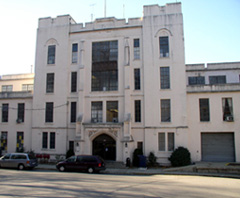While talking to a friend a while back, he said that Charley Kron loves visitors, and last Wednesday I happened to be driving through the area. I gave him a call, he said "Come on by," and I got myself a personalized tour of a real bagpipe shop. There's a lot that goes into making a set of pipes, especially the really nice pipes that Charley makes, and it was fascinating to see how everything came together. He was kind enough to let me use my camera, so here is the tour I got.
This is the outside of the shop, an old industrial building in Dobbs Ferry, NY. It overlooks the Hudson River about 3 miles south of the Tappan Zee Bridge, and is set back from the road a bit. Wandering around in the hallways inside I found the entrance to the shop, and it's behind this simple door with the humble sign that the magic happens.
Walking into the shop, there are bagpipe parts everywhere. I found Charley at a band saw in the back room, and he took me back to the back back room where he had blocks of African Blackwood drying. All the wood he receives comes in blocks about three inches square and already cut to the required length. It's also green and needs to dry before it can make bagpipes. He starts by boring a hole through the center of each block, turning it down on a lathe into a rough cylinder, marking it with chalk to indicate the date, and setting it aside to dry. The blocks will sit from two to four years before he works with them again.
These blocks are spaced out on shelves while they dry. Below are blocks that will eventually become Medalist chanters, and they dry for just as long. He said there are about 300-400 chanters drying in this pile, and another 500 or so on the left side.
After an appropriate drying time, they'll move on to a lathe. The wood shrinks as it dries, which means the center hole gets smaller and needs to be bored out again to the proper size. As soon as the wood is machined it begins to change, so moving from one machine to the next must be done quickly. Also a flaw or knot in the wood might not be visible until the lathe has taken off some wood, and depending on the placement it can leave the whole block unusable. He has a bucket of blocks, drone tops and chanter parts that suffered this unfortunate fate. Below are a few of the lathes he uses to do the boring, profiling, beading, and combing. Charley made all of the tool bits himself.
Note the handle on this lathe; looks like a tenor drone top. He bought the lathe for cheap but it needed some work to make it usable. The lathe below was in the shop of the famous David Glen in 1900, and quite possibly for some time before that. It has been making top-quality bagpipes for well over a century.
Looking around the shop, there are bagpipe parts everywhere in various stages of completion.
Here's Charley in front of a computer controlled lathe that he uses to bore the pipes.
One of Charley's famous products is the Medalist chanter, which he developed in conjunction with Jim McGillivray of Ontario. I can speak to their quality; mine has done very well by me in my solo competitions. I brought in my chanter and he took a look at the bottom; each chanter has a serial number engraved on it. He looked it up in his chanter book and was able to tell me that he finished it in March 2006.
These chanters have been turned down to their final shape. There are no finger holes yet, and they need a finishing coat of varnish, but that's the only work left to be done. Just behind Charley are a few finished chanters that are ready to be shipped to distributors.
Charley also does repairs, and he has a rack of pipes and parts that people have sent him for refitting and repairs. He told me about a few of the projects he has and how he'll take them on.
Most interesting to me was to see the raw ivory he was using for his mounts. All of his ivory was imported before the ban, so it's legal. It's also difficult to work with since a tusk is hollow at the thick end, leaving a relatively small portion of the solid tusk available for machining. Also a crack in the ivory will likely run the entire length of the tusk, making it all but unusable for bagpipe parts. He also works with mammoth ivory, which is difficult to get unless you are the first to look through a shipment from your supplier.
There's a lot more to it than I've let on here, and making pipes is quite a process. Charley is a super nice guy and very happy to give a tour, so if you're traveling through the area I recommend you stop by and see what he's up to. Well worth the few hours I spent there.














No comments:
Post a Comment